Key Events
Autonomys is building an AI infrastructure stack that includes permanent distributed storage, data availability, and decoupled execution, structurally divided into consensus layer, storage layer, and execution layer.
The Autonomys mainnet is being launched in three phases:
Phase One went live in November 2024, enabling the storage and consensus layers;
Phase Two is expected to launch in Q2 2025, introducing Decoupled Execution (DecEx) and AI3 token transferability;
Phase Three is anticipated to launch in 2026, further enhancing scalability through data sharding and expanded domains.
The total amount of staked storage from farmers has increased by 20% year-on-year, rising from 435 PB to 522 PB, with on-chain historical archived data reaching 124 GB.
The cumulative number of events on the mainnet has increased by 203% year-on-year, from 33.9 million to 102.8 million, reflecting a significant increase in network activity. (Events include transactions, farmer voting, token minting, and any information or actions broadcasted on the mainnet)
The circulating market value of AI3 tokens (pre-trading) has decreased by 23% year-on-year, from $193 million to $148 million, with the token price dropping from $0.30 to $0.23, a decline of 24%.
Project Overview
Autonomys Network is an AI infrastructure stack that provides permanent distributed storage, data availability assurance, and supports a modular architecture for building and deploying dApps and on-chain agents.
Storage Layer
Autonomys manages on-chain data through a Distributed Storage Network (DSN), permanently storing and retrieving historical operation records, including AI agent behaviors.
This allows developers and researchers to access, verify, and reproduce agent behaviors without relying on a single node to store all historical data.
Consensus Layer
The network employs a consensus mechanism called PoAS (Proof of Archival Storage), supplemented by a parallel PoT (Proof of Time) chain:
All nodes regularly participate in the archiving phase, dividing the blockchain history into equally sized data segments;
Farmers process and encode the historical segments assigned to them for "plotting";
The network selects farmers proposing new blocks by auditing the integrity of these stored data;
The PoT chain introduces verifiable time constraints between blocks, enhancing security and preventing malicious forks.
Execution Layer
Autonomys adopts a Decoupled Execution (DecEx) architecture, separating consensus from transaction execution.
Operators, elected through a staking mechanism, are responsible for executing transactions and managing state transitions in specific environments.
These environments are called Domains, which are modular execution sub-protocols tailored for specific use cases (such as smart contracts, decentralized AI training, etc.). Each domain is interoperable yet isolated from one another, supporting horizontal scaling of the system:
Auto EVM (formerly Nova EVM) has launched on the testnet Taurus, supporting the deployment and execution of EVM smart contracts;
The Auto ID domain is planned for launch after Phase Two, focusing on managing identities for humans and AI agents.
By distributing execution tasks across multiple domains, Autonomys achieves scalability for large-scale concurrent execution and AI computation tasks.
Key Metrics and Mainnet Progress
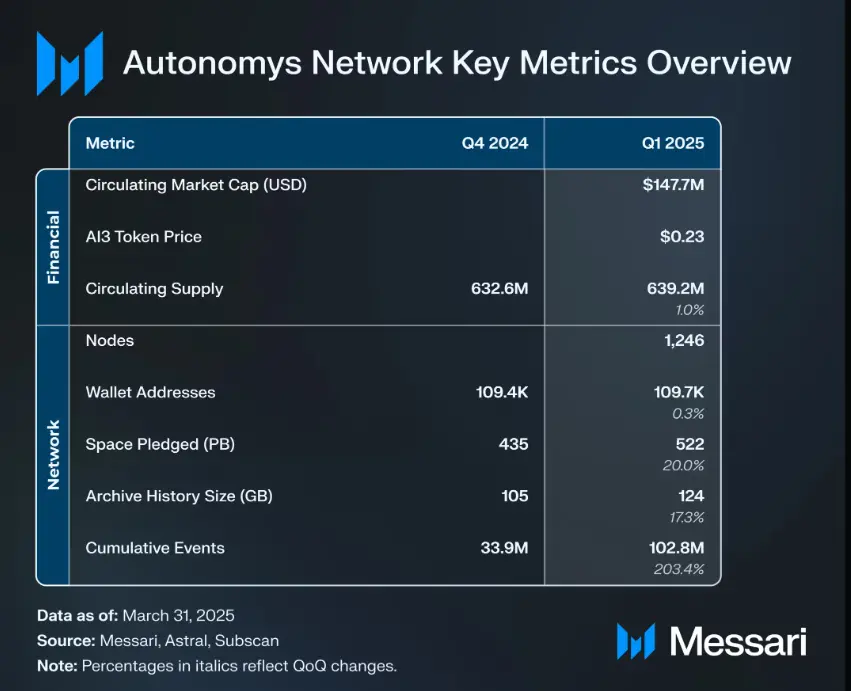
Mainnet Launch Strategy and Timeline
The Autonomys mainnet is being launched in three phases:
Phase One (Phase-1) launched in November 2024, deploying the network's storage and consensus layers. This phase allows farmers to run nodes, accumulate storage capacity, earn mainnet rewards, participate in block production, and build the foundational layer of the Autonomys network. Mainnet activity can be monitored through a real-time telemetry dashboard.
Phase Two (Phase-2) was originally scheduled for Q1 2025 but has been postponed to Q2. This phase will introduce the core Decoupled Execution Layer (DecEx) and will launch:
Auto EVM (formerly Nova EVM): the first EVM-compatible domain for running smart contracts;
AI3 token generation event (TGE) and transfer functionality;
Auto ID will also be launched in H2 2025, which is a self-sovereign identity and personality proof framework designed for humans and AI agents.
Phase Three (Phase-3) is expected to launch in 2026, aiming for large-scale expansion through data sharding and more customized domains, further serving AI and autonomous agent application scenarios. Specific plans are still being finalized.
Mainnet Development Progress
After the launch of Phase-1, Autonomys focused on developing key components necessary for advancing Phase-2 in Q1 2025.
Ambassador Program Update
In December 2024, Autonomys launched an on-demand ambassador onboarding program to optimize the selection and management process for community ambassadors:
All ambassador roles will sign an Ambassador Agreement, clarifying their responsibilities, compliance requirements, and reward mechanisms;
The agreement has been integrated into the stakeholder claim platform backend for easier management and execution.
Autonomys Improvement Proposals (AIPs)
Autonomys officially launched the AIP (Autonomys Improvement Proposal) system in Q1, including proposal documents, processes, and submission procedures, which are now live on the Subspace Foundation website.
Additionally, the team relaunched the Autonomys Academy educational platform in March to educate users about the network and its software product suite.
Auto EVM and Cross-Chain Bridge
In December 2024, Auto EVM officially launched on the testnet Taurus, supporting developers in deploying and testing smart contracts in preparation for Phase-2;
On April 9, 2025, the Autonomys Bridge was launched, supporting cross-chain asset transfers between the Taurus Auto EVM domain and the Ethereum Sepolia testnet.
Auto Agents Framework
On January 28, Autonomys released the Auto Agents Framework, supporting the construction of autonomous, behavior-traceable on-chain AI agents;
All interactions, decisions, and reasoning behaviors of the agents will be permanently archived on the Autonomys network, ensuring auditability, analyzability, and cryptographic verifiability;
Developers interact with the Auto SDK and the PoAS chain and distributed storage network (DSN).
Technical progress includes:
Support for DeepSeek models;
Integration of web search tools;
Agents can perform social actions, such as liking tweets and following users;
Integration of the Model Context Protocol (MCP), providing AI agents with standard interfaces to access external tools and datasets, supporting direct integration with models like Cursor and Claude without custom integration.
Cross-Domain Messaging (XDM)
In Q1, Cross-Domain Messaging (XDM) was launched on Taurus, enabling token transfers between the main chain wallet and domain wallets. At the same time, Autonomys released integration guidelines as part of the “Game of Domains” incentive testing.
Mainnet Roadmap: Key Tasks Before Phase-2 Launch
To complete the Phase-2 mainnet launch, Autonomys has identified the following key milestones:
Final protocol security audit by SR Labs (with an audit tracking link made public to users);
Launch of the Ecosystem Grants program;
Complete exchange listing collaborations for AI3 tokens.
Progress:
The backend system for the Ecosystem Grants Program has been completed and will be launched in sync with the new Subspace Foundation website for project teams to submit applications;
Users are invited to submit proposals in advance to test the process;
Collaborating with Tokensoft to build a Stakeholder Claim Platform for investors, ambassadors, and advisors to access their unlocked or vested AI3 tokens;
The ambassador agreement has been established, and the rights contracts and processes are under development.
Next Focus (Q2 2025)
The product team at Autonomys will focus on post-TGE strategic planning, determining how users will interact with the network in the future, with more details to be released after the launch of Phase-2.
Overall, the execution of the roadmap in Q1 has made substantial progress in technology, ecosystem, and product levels, laying a critical foundation for the launch of the Phase-2 mainnet.
Financial Analysis
Market Capitalization Overview
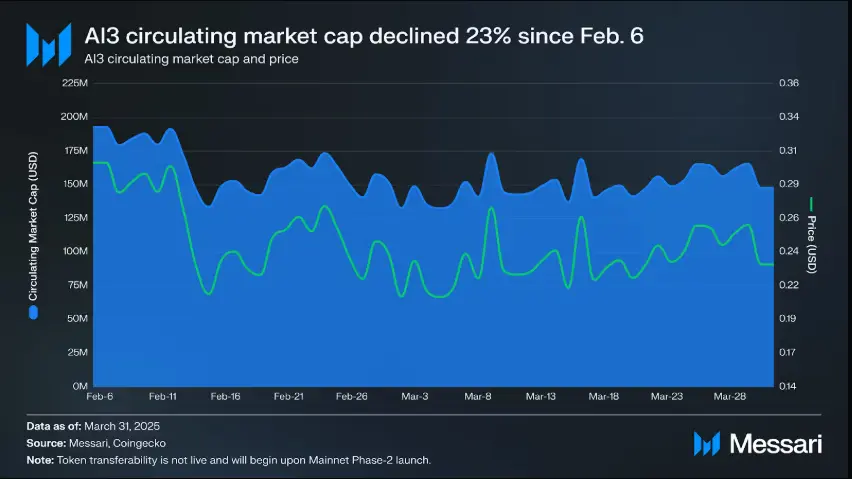
The pre-trading market allows users to buy and sell newly issued or upcoming tokens before they officially launch for spot trading. The AI3 token from Autonomys started pre-trading on February 6, 2025, on XT.com and Gate.io, where investors can exchange locked USDT for pre-issued tokens (pre-token). The official TGE (Token Generation Event) is expected to launch simultaneously with the Phase-2 mainnet, at which point on-chain token transfer functionality will be enabled.
From February 6 to the end of Q1:
AI3 circulating market value decreased by 23%, from $193 million to $148 million;
Token price fell by 24%, from $0.30 to $0.23.
Reward and Fee Structure
The Autonomys network rewards participants who provide security and operational support to the network with AI3 tokens. These rewards come from user-paid fees and AI3 rewards minted through protocol inflation.
Farmers' Revenue Sources:
Providing storage capacity: Contributing solid-state drive (SSD) space to the network;
Revenue earned includes:
Storage fees: Paid by users for storing transactions and data, billed based on transaction size and required resources;
Block rewards: Earned by successfully proposing new blocks on the consensus chain;
Voting rewards: Earned by participating in the consensus voting process.
Operators' Revenue Sources:
Computation fees: Earned from executing and verifying transactions, with amounts dynamically calculated based on the computational resources required for transaction processing;
Relay fees: Used for transmitting cross-domain information (such as asset transfers, state changes, cross-dApp communication, etc.);
Cross-Domain Messaging (XDM) Mechanism:
The sending domain charges computation and relay fees and burns them;
The receiving domain remints the fees and distributes them to operators who successfully complete the message transmission.
Nominators:
When users stake AI3 tokens into an operator's nomination pool,
They can proportionally share in the computation fee earnings earned by that operator.
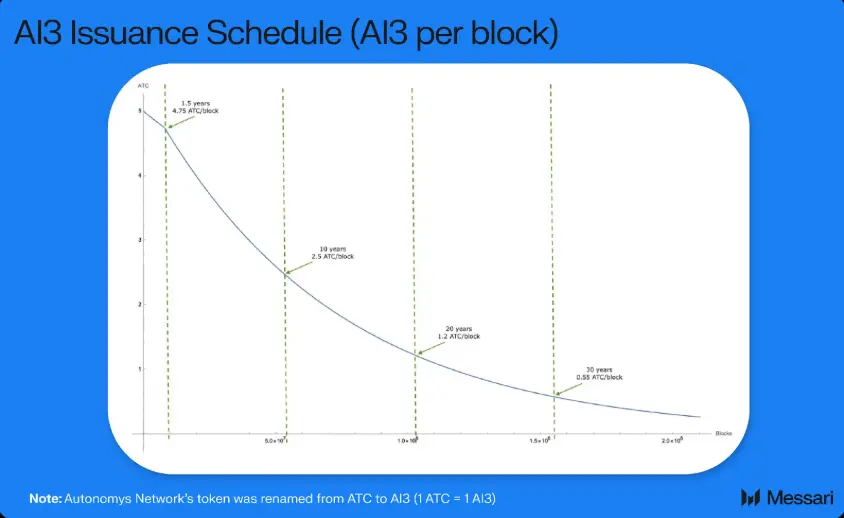
Source: Autonomys Network Issuance Model
The AI3 rewards minted by the Autonomys network follow a dynamic issuance rate, adjusted based on block space demand, with a gradually decreasing plan where rewards will diminish over 40 years. Following the launch of Phase-1 of the mainnet in November 2024, the Subspace Foundation set a requirement that the total committed storage by farmers must reach 210 petabytes (PB) before activating reward issuance. This milestone was achieved by the end of November 2024, after which rewards began to be distributed to block proposers and voters at an initial rate of 5 AI3 per block. The issuance rate then began to decline linearly and will continue to decrease over 1.5 years, expected to reach approximately 4.75 AI3 per block by May 2026. The actual number of AI3 issued per block may vary based on network utilization and voting numbers, but the overall plan will follow the curve shown in the "AI3 Issuance Plan" chart above.
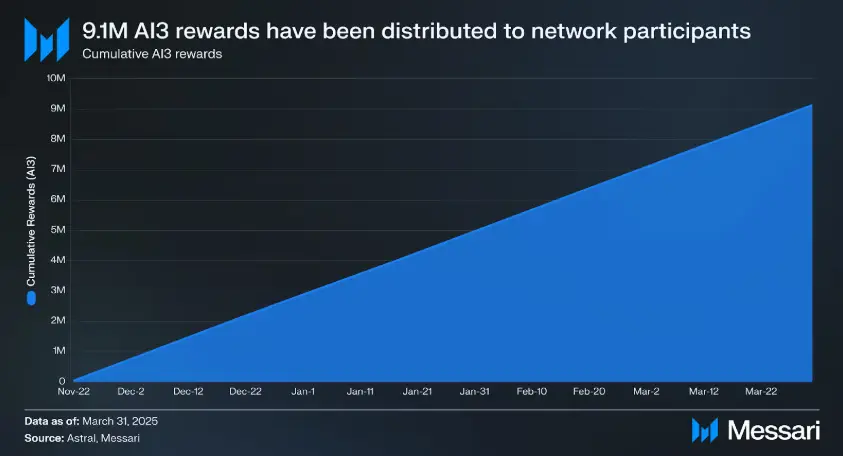
Since the launch of Phase-1 of the mainnet in November 2024, a total of 9.1 million AI3 tokens (0.9% of the maximum supply) have been minted as rewards for network participants.
Network Analysis
Node Count and Roles
The Autonomys network consists of three types of node roles that collectively support the operation of the network infrastructure. These node roles ensure that the storage layer, consensus layer, and execution layer of the network can operate independently and efficiently.
Farmers contribute hard disk storage space to ensure the security of the Proof of Archival Storage (PoAS) consensus chain. They plot the blockchain historical data after segmenting it onto their hard drives, competing for block rewards, and participating in the Distributed Storage Network (DSN). The DSN ensures the permanent storage of blockchain data, allowing nodes and clients to retrieve historical data on demand.
Operators are responsible for maintaining the chain state and executing transactions, operating on the Decoupled Execution (DecEx) chain. DecEx improves network scalability by separating transaction execution from the consensus mechanism. Operators are elected through staking and run in specialized execution environments (called "Domains"), which are designed for specific applications, such as smart contracts or AI training.
Timekeepers operate the Proof-of-Time (PoT) chain and maintain the randomness beacon required for the consensus chain. They are responsible for broadcasting outputs to the network, a process that requires significant CPU computational power.
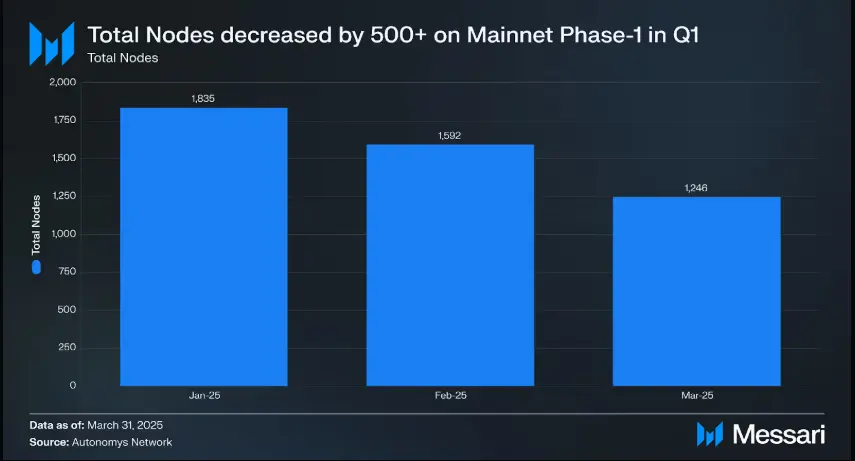
In Q1, the number of nodes on the Autonomys mainnet decreased by 32%, from 1,830 to 1,250. Autonomys is testing domains and cross-domain messaging (XDM) on the Taurus testnet through an incentive staking competition called "Game of Domains," in preparation for the launch of Phase-2 mainnet. The decrease in the number of nodes on the mainnet may be due to some nodes switching to the Taurus testnet to obtain incentives.
Additionally, farming clusters allow users to manage multiple farms through a single node, optimizing workload distribution and reward allocation. As more farmers adopt this approach, the number of active nodes on the mainnet may decline. The decrease in node count without a corresponding reduction in total committed storage may indicate a broader use of farming clusters.
Wallet Addresses
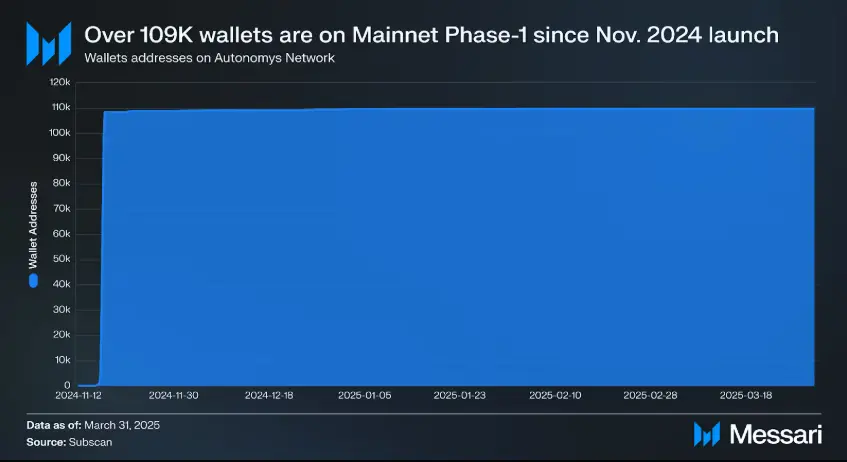
The number of on-chain wallet addresses that used the Autonomys mainnet Phase-1 increased by 0.3% quarter-on-quarter, from 109,400 to 109,700.
Storage
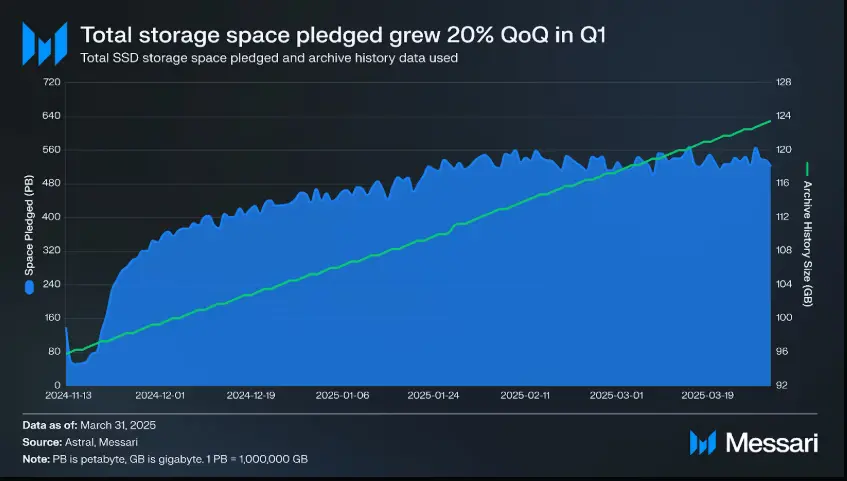
Total committed storage space refers to the cumulative storage capacity promised by farmers for storing and servicing blockchain historical data through the Distributed Storage Network (DSN). Total committed storage space increased by 20% quarter-on-quarter, from 435 PB to 522 PB.
The archived historical size refers to the amount of blockchain historical data that has been converted into permanent archived form and stored in the network's distributed storage system. As of the end of Q1, the archived historical size was 124 GB.
Events
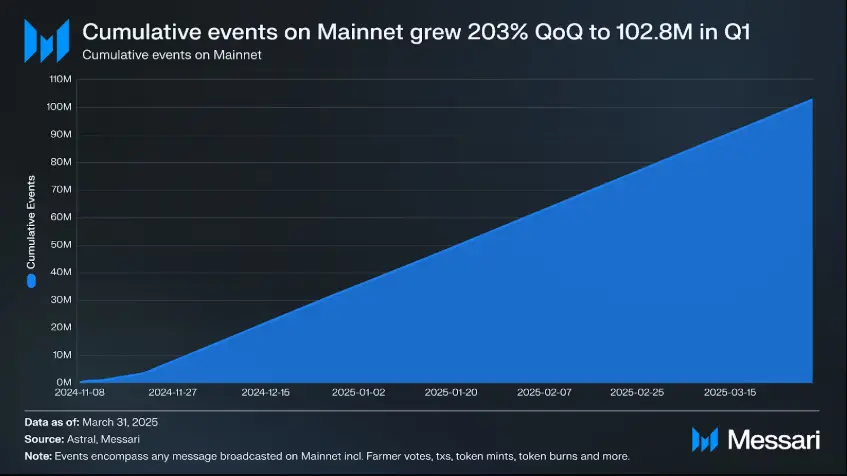
In the Autonomys network, events refer to any messages or operations broadcasted on the mainnet, such as transactions, farmer voting, token minting and burning, or other network activities that trigger state changes or consensus processes. The cumulative number of events on the mainnet increased by 203% quarter-on-quarter, from 33.9 million to 102.8 million.
Ecosystem and Partners
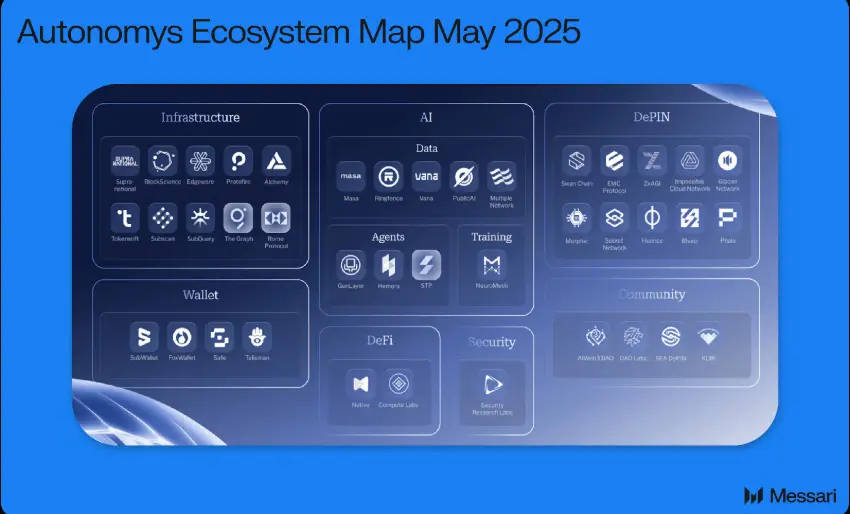
Source: Autonomys Ecosystem Map
Autonomys currently has 37 ecosystem participants, focusing on DePIN and infrastructure protocols. Below are notable partner announcements from Q1.
The Graph, a blockchain data indexing protocol, collaborates with Autonomys to support data access and smart contract indexing, enhancing the performance of decentralized applications (dApps).
Ringfence, a platform for AI content monetization and ownership verification, partners with Autonomys to integrate DSN as a storage option.
Vana, a personal data management platform, collaborates with Autonomys to explore application scenarios for DSN.
Talisman Wallet, a multi-chain wallet, works with Autonomys to integrate the consensus chain, Taurus testnet, and Auto EVM to enhance user access experience.
Phala Network, a secure computing platform utilizing TEE (Trusted Execution Environment), partners with Autonomys to support privacy-preserving AI decentralized applications and smart agents.
Safe, a multi-signature asset management platform, collaborates with Autonomys to deploy multi-signature functionality on the Taurus Auto EVM domain.
Multiple Network, a bandwidth aggregation DePIN, partners with Autonomys to achieve low-latency encrypted data transmission.
DIN (Data Intelligence Network), a decentralized data intelligence network that incentivizes users to collect, verify, annotate, and preprocess AI training data, collaborates with Autonomys to provide on-chain and off-chain data sources for AI smart agents and dApps.
Token Economics
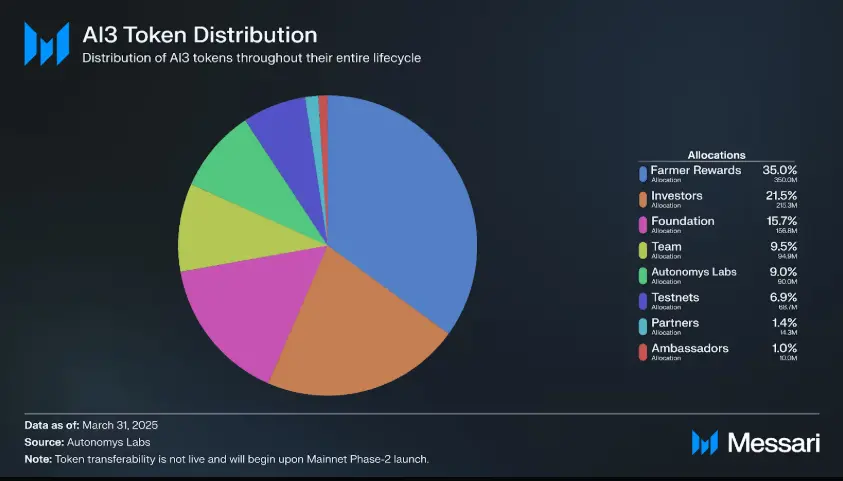
AI3 is the native token of the Autonomys network, with a fixed total supply of 1 billion tokens. At the launch of the mainnet Phase-1 in November 2024, 65% of the tokens (650 million AI3) had been minted, covering all token distribution categories except for Farmer Rewards. The remaining 35% of the tokens will be distributed as block rewards to farmers contributing storage resources over the next 40 years through a dynamic issuance model co-developed with BlockScience. The transferability of the tokens will begin at the Token Generation Event (TGE) during the launch of the mainnet Phase-2. The pre-sale market for AI3 is currently live on XT.com and Gate.io, with the trading pair AI3/USDT.
Of the tokens minted in November 2024, 494.5 million AI3 (49.45% of the total supply) are allocated to investors, the team, Autonomys Labs, the Subspace Foundation, and partners. These tokens are subject to a 48-month lock-up period, with a 12-month cliff period after the launch of the mainnet Phase-2, during which 25% will be unlocked, and the remaining 75% will be released monthly over the next 36 months at a rate of 1/36 per month. Tokens held by investors account for 21.53% of the total supply, while the team holds 9.49%, including founders, advisors, and employees. Autonomys Labs holds 9.00%, of which 7.00% is for the developer treasury, following the same lock-up and release rules, while an additional 2.00% will be unlocked at TGE for liquidity and operations. Partners receive 1.43%, also following the lock-up and release plan.
Additionally, 155.5 million AI3 (15.55% of the total supply) are allocated to operations, the Subspace Foundation, ambassadors, and testnet participants. The Subspace Foundation holds 15.68%, with funds divided into operational expenses, a recent treasury, and a long-term treasury for community projects, grants, and ecological development, which also follows the 48-month lock-up, 12-month cliff, and monthly release rules. The ambassador allocation (1.00%) is unlocked according to participation terms. Testnet and Stake Wars participants receive 6.87%, with no lock-up or release restrictions.
Conclusion
In Q1 2025, the Autonomys Network continues to advance its technical development work for the mainnet Phase-2. Following the successful launch of the mainnet Phase-1 in November 2024, the project has established the storage layer and consensus layer. Key product advancements during the quarter include the launch of Auto EVM supporting smart contract development on the Taurus testnet, the launch of the Autonomys cross-chain bridge supporting asset transfers between Taurus Auto EVM and Ethereum Sepolia, and the deployment of cross-domain messaging (XDM) on the testnet.
Network metrics show increasing participation and activity: total staked storage increased by 20%, from 435 PB to 522 PB; the cumulative number of events on the mainnet increased by 203%, from 33.9 million to 102.8 million. However, the number of nodes decreased by 32%, from 1,830 to 1,250; the circulating market value of AI3 decreased by 23%, from $193 million to $148 million.
In advancing the key dependencies for the mainnet Phase-2, the project has made continuous progress, including ongoing security audits by SR Labs, development of the ecosystem grants program, and integration of the rights claim website with the lock-up contracts and token distribution processes. Autonomys remains focused on completing the Phase-2 launch in Q2 2025, laying the groundwork for scalability upgrades in Phase-3 and the deployment of modular, high-throughput AI infrastructure.
免责声明:本文章仅代表作者个人观点,不代表本平台的立场和观点。本文章仅供信息分享,不构成对任何人的任何投资建议。用户与作者之间的任何争议,与本平台无关。如网页中刊载的文章或图片涉及侵权,请提供相关的权利证明和身份证明发送邮件到support@aicoin.com,本平台相关工作人员将会进行核查。




